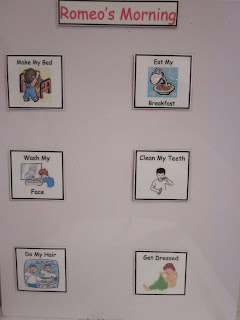Getting out of the house on time with children dressed, teeth brushed, tummies filled and backpacks in hand can be challenging. Getting out the door without nagging, yelling and racing may seem impossible. You can create an environment that teaches your child to take responsibility for his/her morning routine. And, have more pleasant interactions with your child each morning. Doing so will help your child feel more successful and better about him/herself. And your relationship with your child will also likely benefit from a smoother morning routine.
Getting through the morning routine can become relatively stress free. A key is to allow the strategy described below to work. That is, the child is responsible for doing his/her morning tasks. If you take responsibility by reminding, doing for, helping (when help isn’t required) your child will likely let you keep reminding, doing and helping him/her. Such a pattern actually teaches your child he/she doesn’t have to keep track or do his/her morning routine on his/her own. This plan is about teaching your child to take care of his/her morning routine as independently as possible. Here is one way to make your mornings more manageable and enjoyable.
Decide what time you need to walk out the door to be to school on time.
Think about all the things your child needs to do from the time he/she awakes until it is time to walk out the door. Think carefully about how much time is needed to complete the tasks and ensure you and your child have enough time to get everything done. Make a list of the things that need to be done in the order they are to be completed. For young children drawings or pictures maybe helpful on the list and placed on a whiteboard where a marker pen is provided to tick of each task as it is completed.
Think about all the things your child needs to do from the time he/she awakes until it is time to walk out the door. Think carefully about how much time is needed to complete the tasks and ensure you and your child have enough time to get everything done. Make a list of the things that need to be done in the order they are to be completed. For young children drawings or pictures maybe helpful on the list and placed on a whiteboard where a marker pen is provided to tick of each task as it is completed.


Identify with your child a preferred activity he/she would enjoy doing after the rest of the list is completed when he/she has at least 5 minutes of time to spare before it is time to leave. This activity must be approved by you. Some ideas include: doind a puzzle, looking at some books, playing with the dog, playing with a toy etc. Hang the list in a location the child can monitor. Inform your child he/she is to do each task on the list and check them off as they are completed. As your child engages in and/or completes a task provide specific praise for doing so (e.g., good job getting dressed, your hair looks good). You may say things like “Just 2 more tasks and you get to play with your dolly.” “Wow, you are doing great, I bet you will have time for a puzzle this morning.” When your child gets everything done with time to spare, make sure he/she gets to do the fun thing. Be equally diligent in making sure he/she does not get to do the fun activity if everything is not done on time. Walk out the door on time! If your child only gets part of the list done, walk out the door on time! He/she may end up dressing in the car or going to Pre-school with messy hair. The key is not to give in to the temptation to nag or scold or do the task for the child. Rather, talk with his/her teachers and let them know you are working on improving your child’s independence and being responsible so he/she may come to school hungry or with messy hair a few mornings. Chances are this won’t happen very many times before the child figures out how to get through his/her routine successfully. It is easy to eat breakfast on the go and I wouldn’t encourage this if you want breakfast eaten at home. Otherwise, chances are, breakfast will continue to be eaten in the car.
Planning and patience are key. If you give this strategy a try and it doesn’t seem to be working, make sure enough time is allowed for everything to be done, praise is readily being given and access to the fun activity is available after everything else is done. And remember, change takes time.
Planning and patience are key. If you give this strategy a try and it doesn’t seem to be working, make sure enough time is allowed for everything to be done, praise is readily being given and access to the fun activity is available after everything else is done. And remember, change takes time.
No comments:
Post a Comment